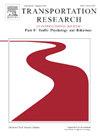Unraveling Interrelationships and Moderators Influencing the Acceptance of Shared Autonomous Vehicles, an End Users' Perspective
IF 3.5
2区 工程技术
Q1 PSYCHOLOGY, APPLIED
Transportation Research Part F-Traffic Psychology and Behaviour
Pub Date : 2025-05-07
DOI:10.1016/j.trf.2025.04.002
引用次数: 0
Abstract
The integration of ride-sharing services with Shared Autonomous Vehicles (SAVs) has the potential to revolutionize future transportation systems. However, the interplay between the internal and external psychological factors, along with the moderating variables influencing the acceptance of SAVs, remains poorly understood. This study addresses this gap by analysing direct effects and interrelationships among latent constructs from the Extended Unified Theory of Acceptance and Use of Technology (UTAUT2), as well as the moderating effects of socio-demographic and travel behaviour variables, using Structural Equation Modelling (SEM). A stated preference questionnaire was designed to collect responses from 723 participants in Tehran. Key findings include: (1) Among the direct effects, performance expectancy, social influence, effort expectancy, habits, hedonic motivation, and price value were significant predictors of intention to use SAVs (listed in descending order of influence); (2) All interrelationships among constructs were positively significant, except for the non-significant effect of social influence on effort expectancy, with social influence demonstrating the strongest effect on facilitating conditions; and (3) Car ownership, driving experience, and accident history emerged as the most influential and frequently observed moderators within the UTAUT2 framework. These results offer policymakers practical insights into public perceptions of SAVs, enabling the identification of underlying preferences and the design of targeted strategies to improve SAV adoption.
从终端用户的角度分析影响共享自动驾驶汽车接受度的相互关系和调节因素
拼车服务与共享自动驾驶汽车(sav)的整合有可能彻底改变未来的交通系统。然而,内部和外部心理因素之间的相互作用,以及影响sav接受的调节变量,仍然知之甚少。本研究通过使用结构方程模型(SEM)分析来自技术接受和使用扩展统一理论(UTAUT2)的潜在构式之间的直接影响和相互关系,以及社会人口统计学和旅行行为变量的调节作用,解决了这一差距。设计了一份明确的偏好问卷,以收集德黑兰723名参与者的回答。主要发现包括:(1)在直接影响因素中,绩效期望、社会影响、努力期望、习惯、享乐动机和价格价值是影响因素的显著预测因子(影响程度由高到低);(2)除社会影响对努力期望的影响不显著外,各构念间的相互关系均显著,其中社会影响对便利条件的影响最大;(3)在UTAUT2框架中,汽车拥有量、驾驶经验和事故历史成为最具影响力和最常被观察到的调节因子。这些结果为政策制定者提供了有关公众对SAV看法的实际见解,从而能够识别潜在的偏好并设计有针对性的策略来提高SAV的采用。
本文章由计算机程序翻译,如有差异,请以英文原文为准。
求助全文
约1分钟内获得全文
求助全文
来源期刊
CiteScore
7.60
自引率
14.60%
发文量
239
审稿时长
71 days
期刊介绍:
Transportation Research Part F: Traffic Psychology and Behaviour focuses on the behavioural and psychological aspects of traffic and transport. The aim of the journal is to enhance theory development, improve the quality of empirical studies and to stimulate the application of research findings in practice. TRF provides a focus and a means of communication for the considerable amount of research activities that are now being carried out in this field. The journal provides a forum for transportation researchers, psychologists, ergonomists, engineers and policy-makers with an interest in traffic and transport psychology.

 求助内容:
求助内容: 应助结果提醒方式:
应助结果提醒方式:


